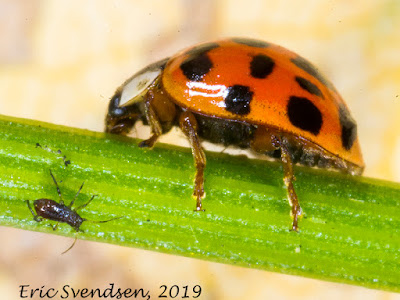What is a mason bee?
 |
| A mason bee on a flower. |
You may have mason bees living near you. If there are preexisting holes present and you see a moderately sized bee (may be mistaken for a large fly) flying in and out of it, you probably have mason bees. Looking further, a mud patch closing the opening secures the deal. Don't be alarmed though, they are truly beneficial. One mason bee does the work of 60 regular honeybees. They are gentle and not likely to sting you. I have a few darting mere inches away from me while I lounge about on a deck chair in my backyard.
Now, what is really amazing is how clever these super pollinators are. They use an existing hole to lay their eggs. What is amazing though is that they will lay an egg, which will develop into a female, at the end of the tube. They provide the food for the eventual larva and then seal it off. In front of that another egg is laid; this time it will develop into a male. More food and the tunnel is sealed. In the meantime, a curious insect, the beefly, may drop by and quickly lay an egg in the open tunnel. The larvae will eat all of the food it finds and then turns upon the developing mason bee larva.
Fortunately, the likely victim will be the male larva and not the female which is tucked away further back in the chamber. One male can fertilize many females, and so their loss is not all that tragic. Furthermore, the gentleman bee larva has sacrificed himself for his developing sister. Not that he ever signed on for such duty. Unwitting chivalry or sacrificial pawn?
Other males, called drones, do not have stingers and are single-minded in their purpose. Their survival gives them more females to mate with because of the life laid down by fellow procreators that never made it to maturity. They would be lucky in more than just one way!
Respect the humble mason bee. An amazing bee in just so many ways.



Comments
Post a Comment